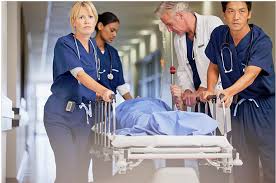The nursing profession is a very important profession that requires an excellent education, years of practice and a lot of experience. The profession of a nurse (in the male version – a nurse) is a very popular specialty, the importance of which can hardly be overestimated. Especially if it is a hospital in a rural area, where work is many times more difficult. However, many people who feel boundless love for people and want to live in order to help them, so such people are looking for every opportunity to do this. A resume of an excellent healthcare professional and just a professional in his field should attract the attention of a recruiter. They always expect to see a top executive resume.
Besides, if you do not want to work in a hospital, but lead a team of nurses, then a resume for executives should reflect the applicant’s deep knowledge in a particular industry. The best executive resume writers can clearly articulate your accomplishments and back them up with facts and figures. Therefore, there are services like executive resume writing services that are the best way to find you the best writer with experience in your field or industry. Such resumes are easily included in the online information scan database. For it, many employers use the https://resumesbot.com/jobscan-ats-resume-checker/ – software, which employers use to scan online job applications for their vacancies.
Because emergency, even if it is not a hospital, but a voluntary organization to help people, is very important. Emergency care in case of accidents is not a characteristic feature of the professional activity of a nurse working in a medical institution. Meanwhile, practice shows that in the event of an accident, the people who are often present at the same time are seized by panic. They, even having theoretical training in the provision of resuscitation care, in extraordinary situations because of this cannot apply their knowledge in practice, and “help” is limited only to appeals “not to touch the victim until doctors appear,” that is, inaction. This is why even the occasional presence of a medical professional with emergency training can be critical to saving human life.
Drowning
Depending on the mechanism of pathogenesis, there are several types of drowning.
Wet drowning occurs when a significant amount of water enters the lungs.
When a small amount of water enters the respiratory tract, a spasm of the glottis (laryngospasm) occurs with dry or asphyxia drowning, which leads to death due to asphyxiation. This mechanism is characteristic of drowning drunken people, drowning of persons with traumatic brain injury.
Syncope drowning occurs due to reflex cardiac arrest when a person suddenly falls into cold water.
The pathogenesis of drowning is characterized by the occurrence of pulmonary edema, the mechanism of which can be different. When seawater, which has a high osmotic pressure, enters the lungs, the liquid part of the blood from the pulmonary capillaries quickly enters the alveoli. When drowning in fresh water, it is quickly absorbed in the lungs, in the pulmonary circulation, the pressure rises sharply, and therefore, the liquid part of the blood also begins to sweat into the lumen of the alveoli; in addition, due to the entry into the blood of a large amount of water, the destruction of red blood cells (hemolysis) occurs.
The clinical manifestations of drowning are as follows. If breathing and blood circulation have not stopped, then the victim is in a state of excitement, sometimes inadequate, convulsions may occur. When breathing stops, the victim’s skin is cyanotic in case of “wet” or pale in case of “dry” and syncope drowning. A pinkish frothy fluid appears from the nose and mouth due to pulmonary edema.
Resuscitation care begins, first of all, with pulling the victim out of the water, and when breathing stops, mechanical ventilation is carried out (if possible) already on the water or in a floating vehicle. Of course, it is impossible to carry out a full-fledged resuscitation benefit under such conditions.
After removing the victim from the water, his mouth is opened using standard techniques and the oral cavity is cleaned of foreign bodies (sand, silt, ooze) with fingers wrapped in cloth. If the victim’s belly is swollen, then the person is quickly turned on the side and pressed with hands on the epigastric region to empty the stomach from water; some authors recommend turning the victim face down and lifting, clasping his body with his hands under his stomach. Placing the victim’s torso with the stomach on the rescuer’s knee, some guidelines advise, requires a lot of physical strength.
The water in the upper respiratory tract (trachea, bronchi) is rapidly absorbed. Trying to remove it, as recommended by some authors, by placing the victim with his stomach on the knee of the rescuer, is apparently inappropriate.
Firstly, precious time is lost (there is a delay in resuscitation), and secondly, as already mentioned above, water is quickly absorbed, so it may simply not be in the respiratory tract.
Secondly, mechanical ventilation must be started even before removing the victim from the water (this has already been mentioned), other types of benefits are simply impossible before that.
Thirdly, physically not everyone can turn over, lift and lay on the knee of an unconscious person.
At the onset of clinical death, after cleansing the oral cavity, a triple dose is performed, mechanical ventilation is continued by the “mouth-to-mouth” method (if the jaws are convulsively clenched, then “mouth to nose”), if apart from cessation of breathing there is also a cessation of blood circulation, a closed heart massage is performed. In the future, when specialists appear, resuscitation is carried out in full (including tracheal intubation, ventilation with a device, oxygen therapy, suction of sputum from the upper respiratory tract, administration of medicinal substances, etc.).

Electrical Trauma
The effect of an electric current on the body depends on many factors: it is variable or constant (in the latter case, a stronger damaging effect is obtained), on its frequency, voltage and strength, on the nature of contact with the skin (dry skin has a much greater electrical resistance than wet), from the place where the electric current is applied to the body. If the current does not pass through the heart and brain, then its damaging effect is much less.
Electric current has both a local effect on the body (electrical burns) and a general one.
The general impact is characterized by the occurrence of spastic contraction of skeletal muscles, which can lead to bone fractures. When electric current passes through the heart, ventricular fibrillation can occur. The effect of the current on the brain leads to respiratory arrest, as a result of which asystole occurs later. If the action of a current of small strength occurs on the body of a person suffering from heart disease, then this can lead to the appearance of arrhythmias.
Help with an electrical injury begins with the cessation of the effect of an electric current on the body (turning off the switch, discarding the electrical wire with a dry stick, cutting the cable, etc.). When cessation of breathing is performed by mechanical ventilation after a triple dose (you need to remember about the possibility of a fracture of the cervical spine due to spastic muscle contraction), if there is a cessation of blood circulation, then a precordial blow is applied twice and a closed heart massage is performed in combination with mechanical ventilation.
Strangulation (Hanging)
When suffocating (hanging), asphyxia occurs due to compression of the neck organs. Due to asphyxia, asystole occurs. Strangulation can be accompanied by injury to the cervical spine, damage to the trachea of the larynx, large vessels of the neck.
Depending on how quickly the effect of the asphyxiant factor is discontinued, the clinical picture may be different, but the diagnosis is not difficult. Loss of consciousness quickly sets in. The face and neck of the victim are cyanotic, puffy, hemorrhages are visible on the sclera. There is a so-called strangulation groove on the neck when hanging. Respiration stops, and then blood circulation (clinical death). After the cessation of the effect of the suffocating factor, the victim may experience convulsions and develop hypoxic cerebral edema.
Assistance is provided in an amount depending on the condition of the victim. In the beginning, of course, the action of the suffocating factor, for example, a rope loop, is stopped. Resuscitation is carried out according to general principles. When providing resuscitation benefits, you must remember about the possibility of injury to the cervical spine.
